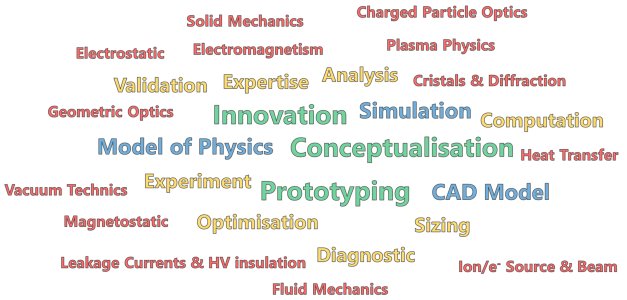ProtoSTEP offers a wide range of expertise in Physics applied to various concerns. We have ten years of experience in Academic research and Industrial R&D. Each field is considered independently or in a multi-physics interaction according to the need.

Electromagnetism enables the study of the Coulomb interactions between charged particles and their coupling with the electric and magnetic fields created. The basic equations are driven by the so-called Maxwell’s equations.
Within an electrical conductor, they give the electric current distribution with the corresponding electric potentials. In vacuum, they describe the propagation of charged particule beams including the related electric fields.
In the particular case of charged particules within a low pressure gas, Plasma physics expertise is necessary to consider for example space charge effect, Debye shielding or reactional mechanisms such as ionization or dissociation.
- Case study: Electrical contact, scanning electron microscope (SEM), mass spectrometer, Hall effect sensor, capacitive sensing
Optics originates in electromagnetics and focuses on the propagation of the electromagnetic waves in vacuum or materials including their interaction such as interference, absorption, reflection, resonance and diffraction. Maxwell’s equations allow computation of the so-called wave equation.
- Case study: Diffraction spectrometer, resonant cavity, wave guide, optics bench, electromagnetic shielding, antenna radiation
Heat transfers can be linked to electromagnetics by considering phenomena such as inductive heating, electromagnetic radiation, or ohmic losses (Joule effect). Thermalisation is computed from the so-called Heat equation that describes balance between gain and loss terms, including convection, conduction and radiation phenomena.
- Case study: Heating of an electrical contact, baking of a vacuum chamber, induction furnace, cooling system, heat sink, heat shielding
Fluid mechanics allows the study of several flow regimes (laminar, transient and turbulent) in gases or liquids. It orignates in the so-called Navier-Stokes equation.
- Case study: Water cooling circuit, vacuum chamber, pumping circuit
Solid mechanics allows the study of the dynamics of one or more rigid objects by considering the Newton laws of motion.
The particular case of a non-rigid object takes into account the distortion tensor with the constraints generated by the external forces.
- Case study: Mechanical contact, vacuum chamber, pressurized bottle, loading of a system
